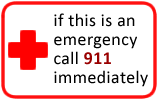Leg Injury
Leg Injury
Does this describe your child's symptoms? |
Click image for more info |
Definition
Types of Leg Injuries
Pain Severity Scale
|
If not, see these topics
|
When to Call Your Doctor |
Call 911 Now (your child may need an ambulance) If |
|
|
|
Call Your Doctor Now (night or day) If |
|
|
|
Call Your Doctor Within 24 Hours (between 9 am and 4 pm) If |
|
|
|
Call Your Doctor During Weekday Office Hours If |
|
|
|
Parent Care at Home If |
|
|
HOME CARE ADVICE FOR MINOR LEG INJURIES |
Treatment of Pulled Muscle, Bruised Muscle or Bruised Bone:
Reassurance: Bruised muscles or bones can be treated at home.
Pain Medicine: For pain relief, give acetaminophen OR ibuprofen as needed. (See Dosage Table). Ibuprofen is more effective for this type of pain.
Local Cold: For bruises or swelling, apply a cold pack or ice bag wrapped in a wet cloth to the area for 20 minutes per hour. Repeat for 4 consecutive hours. (Reason: reduce the bleeding and pain)
Local Heat: After 48 hours apply a warm wet washcloth or heating pad for 10 minutes three times per day to help absorb the blood.
Rest: Rest the injured part as much as possible for 48 hours.
For pulled muscles, teach your youngster about stretching exercises and strength training.
Treatment of Mild Sprains (stretched ligaments) of Ankle or Knee:
First aid: immediate compression and ice to reduce bleeding, swelling, and pain.
Treat with R.I.C.E. (rest, ice, compression, and elevation) for the first 24 to 48 hours.
Apply compression with a snug, elastic bandage for 48 hours. Numbness, tingling, or increased pain means the bandage is too tight.
Apply a cold pack or ice bag wrapped in a wet cloth to the area for 20 minutes per hour. Repeat for 4 consecutive hours.
Give acetaminophen (e.g., Tylenol) or ibuprofen for pain relief. Continue for at least 48 hours.
Keep injured ankle or knee elevated and at rest for 24 hours.
After 24 hours, allow any activity that doesn't cause pain.
Expected Course: Pain and swelling usually peak on day 2 or 3. Swelling is usually gone by 7 days. Pain may take 2 weeks to completely resolve.
Call Your Doctor If:
Pain becomes severe
Pain is not improving after 3 days
Pain lasts over 2 weeks
Your child becomes worse
And remember, contact your doctor if your child develops any of the "Call Your Doctor" symptoms.
Updated:
March 22, 2017







